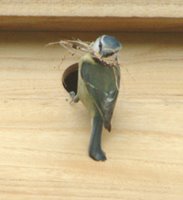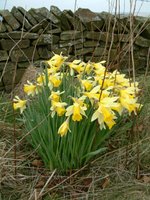Spring is a very busy time for nesting birds so consider putting up a bird box.
Holed nest boxes come with various hole sizes, each attractive to some birds and not others. Smaller holes also exclude larger birds. 25mm is ideal for blue tits, marsh tits and coal tits, 28mm for great tits, tree sparrows and pied flycatchers, 32mm for house sparrows, nuthatches and lesser spotted woodpeckers, 45mm for starlings and 50mm for great spotted woodpecker.
 The height of the front on open-fronted boxes attracts different birds. A 60mm high front attracts spotted flycatchers, 100mm attracts robins and pied wagtails, and 140mm attracts wrens.
The height of the front on open-fronted boxes attracts different birds. A 60mm high front attracts spotted flycatchers, 100mm attracts robins and pied wagtails, and 140mm attracts wrens.
Sparrows like to nest communally. They will welcome a ‘terrace’ which has 3 nest boxes in one with individual entrances.
You could tie up some nesting materials such as dry grass, small twigs, hair clippings and wool in an accessible place away from cats.
 I bought a bag of baby leaf salad leaves from Tesco today. I was tucking in when I came across some Shepherd's Purse (Capsella bursa-pastoris). I thought it was a mistake as it's a common field weed but I just checked online and it is edible. Rather nice too - flowers, seeds and all. It's full of vitamins apparently and the Romans grew it as a pot herb. It has a long history of use to treat haemorrhages...which could be handy as it's a Friday night!
I bought a bag of baby leaf salad leaves from Tesco today. I was tucking in when I came across some Shepherd's Purse (Capsella bursa-pastoris). I thought it was a mistake as it's a common field weed but I just checked online and it is edible. Rather nice too - flowers, seeds and all. It's full of vitamins apparently and the Romans grew it as a pot herb. It has a long history of use to treat haemorrhages...which could be handy as it's a Friday night!






